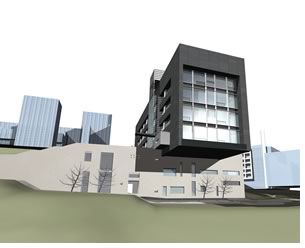

SmithGroup Breaks Ground
on Lawrence Berkeley National Laboratory Molecular Foundry
Nanotechnology center one of first in nation
 SmithGroup
and the State of California celebrated the groundbreaking of the Lawrence
Berkeley National Laboratory Molecular Foundry on January 30. The Foundry,
a landmark for the state, will serve as one of the few facilities in the
country dedicated to nanotechnology, the study of materials at the atomic
or molecular level. The 96,000-square-foot Molecular Foundry project sits
partially tucked into a hillside above the University of California, Berkeley,
and its full-height windows allow principal investigators to enjoy spectacular
views of the San Francisco Bay. Inside, interaction spaces support collaboration
among researchers and link the laboratories at one end of the building
with offices at the other.
SmithGroup
and the State of California celebrated the groundbreaking of the Lawrence
Berkeley National Laboratory Molecular Foundry on January 30. The Foundry,
a landmark for the state, will serve as one of the few facilities in the
country dedicated to nanotechnology, the study of materials at the atomic
or molecular level. The 96,000-square-foot Molecular Foundry project sits
partially tucked into a hillside above the University of California, Berkeley,
and its full-height windows allow principal investigators to enjoy spectacular
views of the San Francisco Bay. Inside, interaction spaces support collaboration
among researchers and link the laboratories at one end of the building
with offices at the other.
“The Molecular Foundry will be a national center for nanoscience—the design, synthesis and characterization of nanoscale materials, says Jim Krupnick, LBNL’s project director, “Nanoscience shows enormous promise for advances in medicine, computing, energy efficiency, in fact, virtually all fields of science.”
 LBNL
is the oldest U.S. Department of Energy national laboratory. It has produced
nine Nobel laureates and many revolutionary advances across the spectrum
of science in its 71-year history. The lab already is accepting applications
from researchers across the country who would like to work at the Molecular
Foundry. Most will stay for a few weeks or months to work with the range
of sophisticated equipment available at the site, helping speed innovation
and collaboration among companies. The building will include an electron
microscope imaging lab plus materials science, molecular biology, inorganic
and organic chemistry, and computational laboratories.
LBNL
is the oldest U.S. Department of Energy national laboratory. It has produced
nine Nobel laureates and many revolutionary advances across the spectrum
of science in its 71-year history. The lab already is accepting applications
from researchers across the country who would like to work at the Molecular
Foundry. Most will stay for a few weeks or months to work with the range
of sophisticated equipment available at the site, helping speed innovation
and collaboration among companies. The building will include an electron
microscope imaging lab plus materials science, molecular biology, inorganic
and organic chemistry, and computational laboratories.
The SmithGroup made sure that the Foundry incorporates green design elements that will qualify it for a U.S. Green Building Council’s LEED™ (Leadership in Energy and Environmental Design) Silver rating. The Foundry’s energy consumption is designed to fall 30 percent below the state’s strict standards for laboratory buildings. Additionally, 75 percent of construction waste will be recycled. Low emission and renewable materials, such as bamboo flooring and paneling, create a greener and healthier indoor environment. The architects estimate that construction will be complete in early 2006.
Copyright 2004 The American Institute of Architects.
All rights reserved. Home Page ![]()
![]()
 |
||
|
Images courtesy of the architect.
|
||